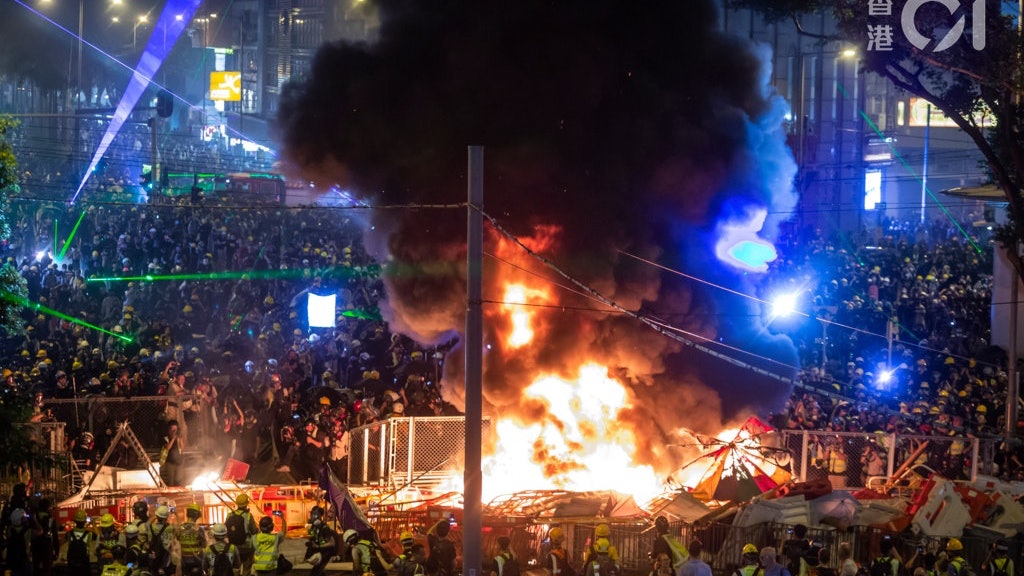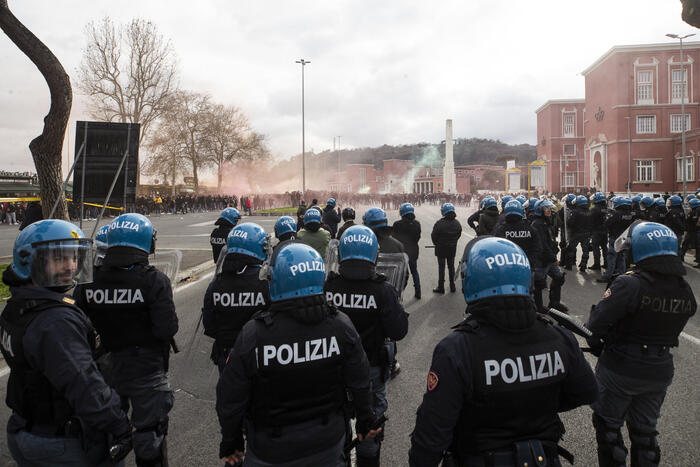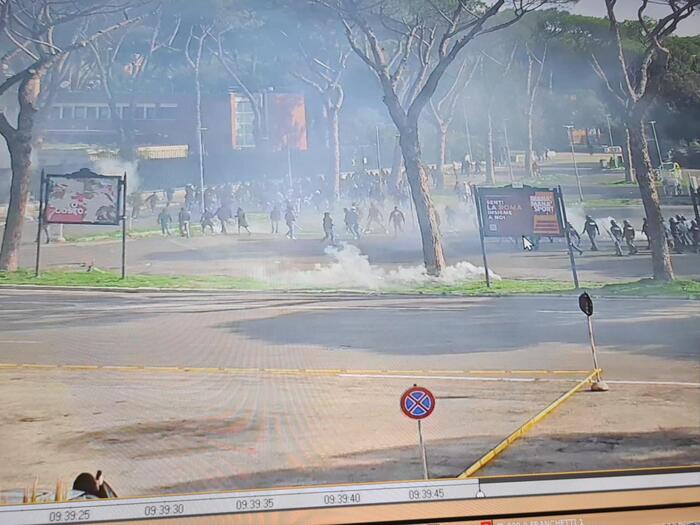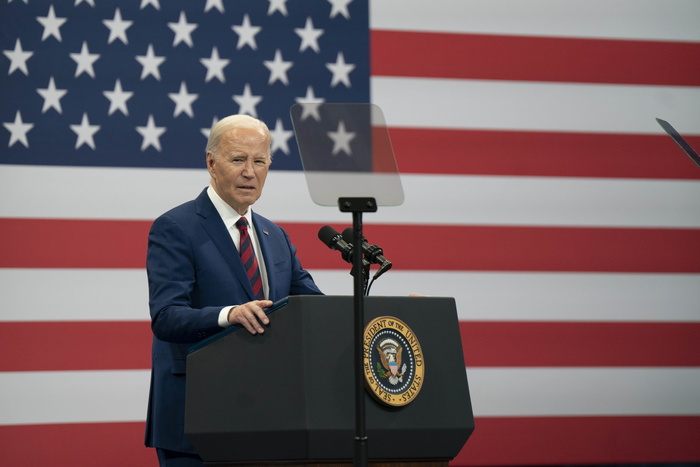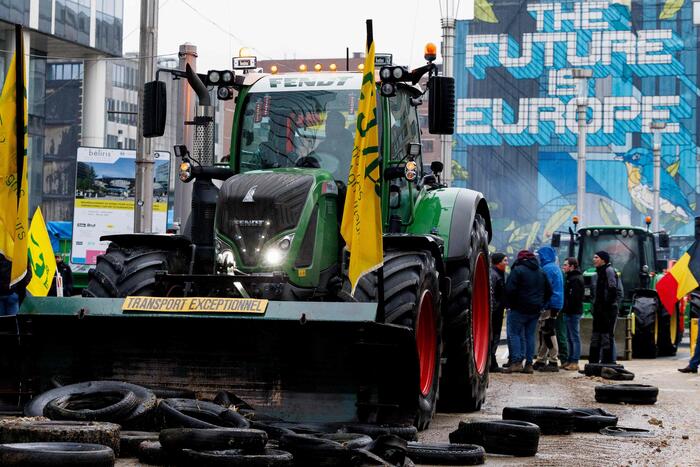Political situation
Written by: Wen Weiguang
2020-09-02 08:00
Last update date: 2020-09-02 12:59
In the past few decades, local social movements have given people the stereotype of etiquette. In 2014, the occupation movement led by "peace and justice" ended in failure. The overthrow of the "People's Congress 8.31" decision and the fight for "true universal suffrage" were in vain.
By the time of the riots in Mong Kok in 2016, the bricks were set on fire, and the brave struggle sprouted.
In 2019, the situation in Hong Kong changed. The wave of opposition to the amendment of the Fugitive Offenders Ordinance entered August and "bloomed everywhere" and swept across Hong Kong.
After learning the lessons of Occupy Central and incorporating the elements of the Mong Kok riots, the demonstrators no longer miss the "position war". The paralysis of traffic in various districts and the arson of bricks made those in power unexpected. The 18 districts of Hong Kong left signs of "war damage". .
The anti-revision rule camp adopts "Be Water" as its strategy and advocates "flash-flash" operations. It has become the norm to set up obstacles on the road and gather in large shopping malls.
The psychedelic atmosphere of "unity and courage" enveloped the society. The lit petrol bombs vented like anger on the police force. The tear gas bombs used to suppress the demonstrators flew across the downtown area. People seem to collectively lose the ability to distinguish between true and false. The July 21 attack by the white-clothed men in Yuen Long and the 8.31 turmoil at Prince Edward Station have torn even bigger wounds between the police, the government and the government.
[Minutes of the amendments.
The first session] Lam Cheng finally underestimated the enemy's democrats to counterattack with anger
[Minutes of the amendments.
Second episode] The police are dissatisfied with smoldering civil servants and misjudgment
On August 5, the demonstrators launched a "third stop", and a fully equipped demonstrator in Wong Tai Sin was by the roadside.
(Profile picture / Photo by Luo Junhao)
"Be Water" paralyzed all traffic in Hong Kong
On August 5, at 1 am, Kwai Chung Road flyover vehicles were coming and going, carrying countless people returning home.
Several demonstrators dragged iron fences, wooden boards, trash cans and paper sheets to the bridge and intercepted three traffic lanes. Someone quietly lit the fire. The sundries caught fire in front of the vehicles. The smoke rose to mid-air and the vehicles could not move forward. I can only press irritably, and there are noises from the adjacent housing estate. Passengers who got off the car were beaten to their heads in disputes. More than a hundred demonstrators occupied the road for a long time. The iconic 8.5" was an anti-revision demonstration. The ban on the third party" and demonstrations across Hong Kong kicked off.
The Hong Kong government seemed to underestimate the situation and failed to stop it as soon as possible, which encouraged the demonstrations to "bloom everywhere". The demonstrators adopted "Be Water" as their action strategy. They "flashed" in Wong Tai Sin in the early morning. Demonstrators continued to block Lung Cheung Road. Traffic in the direction of East Kowloon was cut off almost all day, and major arterial roads such as Tuen Mun Road and Castle Peak Road were also blocked. The Hung Hom Cross-Harbour Tunnel, Eastern Cross-Harbour Tunnel and Western Cross-Harbour Tunnel were once blocked by the Water Horse.
Affected by the uncooperative movement, many MTR lines were suspended. This morning, Hong Kong traffic was almost paralyzed, which touched the nerves of the government.
At 10 a.m. that day, Chief Executive Carrie Lam Cheng Yuet-ngor led a group of senior officials to meet with the media.
After two months of turmoil, and the July 21 attack on the prestige of the government and the police force by the white-clothed men in Yuen Long, Lam Cheng was obviously tired. She tremblingly rebuked: "They threatened to revolutionize and recover Hong Kong. These actions have far surpassed the original political demands. These illegal actions that challenge national sovereignty and endanger one country, two systems will destroy the stability and prosperity of Hong Kong... This kind of practice that some people describe as burning jade and stone will put Hong Kong on a path of no return." He is quite different from the chief executive who plausibly pushed the amendment under the camera six months ago.
Ironically, gun smoke continued to spread outside, gasoline bombs were flying wild, roads could not be opened, multiple district police stations were destroyed, dissidents fought with each other, radical demonstrators and police officers met in hand, and for the first time in the chaos, police officer Qingtian shot and warned. .
On August 5th, the demonstrators launched a "third strike", using "Be Water" as their action strategy, and they started to act in the early morning.
Affected by the uncooperative movement, many MTR lines were suspended. This morning, traffic in Hong Kong was almost paralyzed.
(Photo/Photo by Ou Jiale)
Lennon Wall in District 18 gathers demonstrators
The anti-revision movement has been described by many as a model of "no big platform" resistance.
As early as the Occupy Central in 2014, "dismantling the big platform" was already the goal of the younger generation of protesters.
In the summer of last year, the visible big platform was completely removed and replaced with the online discussion forum "Lian Dang" and the instant messaging application "Telegram" as the strategic platform.
In the virtual world, demonstrators opened up new ways of connecting, which determined the direction of the movement.
"Tactical Valley", "Information Team", "Public Propaganda Team"...The movement participants seem to have found their own roles, and an organization structure with an orderly division of labor has implicitly formed.
The "Propaganda Group" is one of the strange landscapes.
If "flowering everywhere" is the main body of the movement, then the Lennon Wall in each district is a supplement to nourish it.
Unlike the Occupy Movement in 2014, under the anti-revision demonstrations, all 18 districts in Hong Kong have Lennon Walls, each with its own characteristics. A column, a corridor, and a staircase have become platforms for protesters to express their demands.
Xiao Mei (pseudonym), who collects and researches publications, described: "Lennon Wall not only provides citizens expressing their complaints, but also an information platform for anti-amendments. It has a wide range of events, hot talk, and mainstream media without reports. Event, the propaganda is supported by Fact Check and data, which can make more neighborhoods aware of the anti-revision case."
After the 7.21 Yuen Long incident, the whole city was directed at the police force, and there was even the saying of "police and black collusion." The propaganda on Lennon's wall also turned to law enforcement against the police force. Xiao Mei analyzed: "Two uniformed policemen chose to leave regardless of the safety of the citizens. At the scene, it was ridiculous that people who were not concerned about the anti-amendment law joined the demonstration. If the propaganda system promotes more people to participate in the demonstration, it shouldn’t be surprising.” This probably means that even the Nong Wall and "Bloom everywhere." Inseparable relationship between.
After the 7.21 Yuen Long incident, the whole city was directed at the police force, and there was even more talk of "police and criminal collusion." The propaganda on Lennon's wall also turned to the police force.
(Photo/Photo by Yu Ruijing)
Oppose the "Flash" led by TG
After the victory was reported in the "third year", the demonstrators planned the next wave of action-8.11 "Flash" across Hong Kong.
The demonstrators followed the online "action post" call, and they blocked roads and vandalized at 12 noon. There were signs of "battle damage" in Hong Kong, Kowloon and New Territories. Police stations in various districts became targets of destruction. At 6 o'clock in the evening, the demonstrators Surrounded the Tsim Sha Tsui Police Station, some demonstrators set fire to the police station and dumped petrol bombs. A police officer in the police station was sent to hospital with burns. The commander ordered "Operation to Defend the Police Station" at 7:30 p.m. The police fired at least 8 towards Nathan Road. After the pouch bullet was released, a young girl fell to the ground due to a shot in the eye, and the battlefield in Tsim Sha Tsui calmed down.
However, on the other side, the fire is still everywhere in Hong Kong. Telegram announced the results of the poll in the evening, suggesting a "flash" the CHT. The toll area of the CHT outside the Polytechnic University has been paralyzed; Kwai Fong Station was damaged at 9 pm Forced the police to shoot tear gas in the station; during the late night fighting in Causeway Bay, police officers disguised as demonstrators suddenly uniformed many people on Percival Street. The demonstrators were crushed. Waterloo in Causeway Bay drove many people to "fight" Taikoo, and the Speed Dragon team was early. The first opportunity was intercepted inside the station, and pepper shot guns were fired at close range from the escalator. The demonstrators could not escape, causing adults to step on people.
On 8.11, the police force was attacked overnight. Various operational strategies have been questioned. The then Commissioner of Police, Lu Weicong, did not meet with the media after visiting his injured colleague that night. He only expressed his indignation through a statement by the Public Relations Division, which he strongly condemned and emphasized that he must be held accountable. At the same time, the anti-revision law camp has also suffered heavy damage. A front-line demonstrator said: "This is a long-term struggle. There will be democracy after the inquiry today. Foreign media have also watched it. The demonstrators are not right. How to be suppressed by the police after the use of force, and this battle also proved that there are many possibilities in the absence of a big audience. I will not see it in 2014."
On 8.11, the police force was attacked overnight, and various operational strategies were questioned. The picture shows the then Commissioner of Police, Lu Weicong.
(Data Picture/Photo by Zeng Ziyang)
Shopping mall battle "shop with you" becomes the norm
"Bloom everywhere" and "Flash" became the main tunes in the future.
Entering September, an unprecedented mode of demonstrations gradually sprouted-shopping mall demonstrations.
Tracing back to the source, on the night of the Sha Tin Parade on July 14, demonstrators occupied Sha Tin’s New Town Plaza. The dispersal operations deployed by the police did not seem to go smoothly. Police officers were beaten and beaten by their fingers, and confronted the demonstrators. In other words, this mall battle can be regarded as a "five-five wave."
On the Internet that night, there have been discussions on opening up the shopping mall demonstration front, and some people even threatened to "decorate" (the demonstrator's term, that is, destroy) the "red shops" (Chinese-funded enterprises) in major shopping malls and shops with opposing political views, but there are also opinions It was thought that demonstrations in shopping malls were no different from beasts, and they ended up in the end.
Until September 14, a member of the "Loyalty Citizens Group", also known as "Dabo Man", had a bloody clash with over 100 patriots during the high-profile support of the police at the Amoy Plaza in Kowloon Bay. The police came to the scene. After being questioned for unfair law enforcement, the possibility of demonstrations in shopping malls was again studied on the Internet.
Even though Article 50 of the Police Force Ordinance stipulates that police officers can freely enter and search if they have reason to believe that a person to be arrested is in a certain place. However, some legal scholars argue that it is difficult to define a person to be arrested. Netizens also tend to regard shopping malls as a truce. "Districts", one-way believe that the police will not enter rashly; moreover, advocates emphasized that the shopping malls demonstrated "peace" in order to attract "peaceful" citizens and unite the people.
"To engage in shopping malls is to put pressure on the real estate developers, so that the government will be pressured, and the government will use its strength to get a lot of "red shops" and force them to lock the doors." A demonstrator added: "Police At first, I seemed to hesitate. I don’t always enter the mall every time. Most of the time I go in. Besides, I have to leave when my actions are achieved. There is no difference between fighting in the mall and fighting with the beasts.” Every Saturday and Sunday will be famous. Shopping malls such as Central ifc, Tsim Sha Tsui Harbour City, Mong Kok Moko, Festival Walk, Kowloon Tong, Telford Plaza, Kowloon Bay, etc., have demonstrators stationed in "shop with you", and smaller "lunch with you" Held at lunchtime on Sunday.
The first shopping mall occupied by the demonstrators was Sha Tin New Town Plaza. The dispersal operation deployed by the police that night was not smooth.
(Data Picture / Photo by Yu Junliang)
"Dragon Squad" attacked the police with gasoline bombs
As the anti-revision law camp becomes more and more vigorous, the police force, which has been passive, has clearly adjusted its strategy. The water cannon truck was dispatched to clear the field for the first time on August 25. After the demonstrations in Hong Kong on August 31, it took the initiative to enter the Prince Edward Station to enforce the law. Police batons were distributed to off-duty police to mix in with demonstrators to enforce the law. Later, the "Guidelines on Forces" were revised to relax restrictions on weapons that can be used.
The increased equipment and force of the police force did bring about a deterrent effect, which caused confusion among the demonstrators for a while, but the side effect was to deepen the hostility between the two sides and form a greater conflict between the police and the people than in 2014.
The relationship between the police and the public has quickly eroded in street confrontations and shocks. On the one hand, the people are dissatisfied that the police did not face up to the incidents of 7.21 and 8.31, and avoided disputes such as police officers suspected of condoning attacks by "white men" and excessive use of violence in law enforcement. On the other hand, an irrational atmosphere is growing in a torn society. Conspiracy theories on social networks-such as "8.31 Prince Station Killing People" and other false propaganda continue to catalyze the struggle.
The accumulating resentment among the people is getting bigger and bigger, and a group of "dragon slaying squads" that are more violent than the brave sect appear in a posture of venting the people of Hong Kong.
They did not use their shields to resist the police offensive during the demonstrations, but threw petrol bombs at police officers and police stations, and even buried themselves and injured them.
Some demonstrators followed suit. Many police stations were surrounded. Mong Kok Police Station has been the target of snipers for many consecutive nights.
The police recorded the number of attacks on police stations in the past year. From June last year to the end of June this year, 37 police stations in Hong Kong suffered a total of more than 200 damages, of which 24 police stations were hit by petrol bombs at least 66 times. Police in Tsim Sha Tsui and Mong Kok The numbers were 10 and 9 times respectively.
Many police stations are still being repaired so far. The water horses continue to surround the police station firmly, the police officers are still on high alert, and the battle between the police force and the demonstrators is at a high level. Whether the gap can be repaired in the short term is still undermined...
(End of the third round)
Anti-revision demonstrations, independent investigation committees, demonstrations, police-civil conflicts, police-civil relations, gasoline bombs, my home ground 01 Video Fugitives Ordinance

